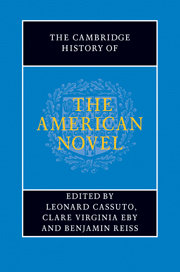Book contents
- Frontmatter
- General Introduction
- PART ONE INVENTING THE AMERICAN NOVEL
- PART TWO REALISM, PROTEST, ACCOMMODATION
- PART THREE MODERNISM AND BEYOND
- PART FOUR CONTEMPORARY FORMATIONS
- Introduction: contemporary formations
- 58 Postmodern novels
- 59 The nonfiction novel
- 60 Disability and the American novel
- 61 Model minorities and the minority model – the neoliberal novel
- 62 The American borderlands novel
- 63 The rise of the Asian American novel
- 64 Toni Morrison and the post-civil rights African American novel
- 65 Hemispheric American novels
- 66 The worlding of the American novel
- 67 The Native American Tradition
- 68 Contemporary ecofiction
- 69 Graphic novels
- 70 Twentieth- and twenty-first-century literary communities
- 71 A history of the future of narrative
- A selected bibliography
- Index
67 - The Native American Tradition
from PART FOUR - CONTEMPORARY FORMATIONS
Published online by Cambridge University Press: 28 July 2011
- Frontmatter
- General Introduction
- PART ONE INVENTING THE AMERICAN NOVEL
- PART TWO REALISM, PROTEST, ACCOMMODATION
- PART THREE MODERNISM AND BEYOND
- PART FOUR CONTEMPORARY FORMATIONS
- Introduction: contemporary formations
- 58 Postmodern novels
- 59 The nonfiction novel
- 60 Disability and the American novel
- 61 Model minorities and the minority model – the neoliberal novel
- 62 The American borderlands novel
- 63 The rise of the Asian American novel
- 64 Toni Morrison and the post-civil rights African American novel
- 65 Hemispheric American novels
- 66 The worlding of the American novel
- 67 The Native American Tradition
- 68 Contemporary ecofiction
- 69 Graphic novels
- 70 Twentieth- and twenty-first-century literary communities
- 71 A history of the future of narrative
- A selected bibliography
- Index
Summary
In 1854 Cherokee outlaw John Rollin Ridge wrote The Life and Adventures of Joaquin Murieta: The Celebrated California Bandit, the first novel by a Native American. Years before, in 1839, Ridge's father John Ridge and others had gathered covertly to sign away Cherokee title to ancestral homelands in the east and to move the Cherokees west. For selling Cherokee land without consent of the nation, a band of traditionalists gathered one night at the Ridge house and brutally assassinated the father before the eyes of the son. John Rollin Ridge vowed revenge and one day killed a man he suspected to be one of his father's murderers. Fleeing to the California gold fields, John Rollin Ridge may have endured his banishment imagining himself the California bandit Joaquin Murieta, the Hispanic folk hero who robs the wealthy to support the weak throughout the land.
Not all Native American novels bear such complex histories, but since Joaquin Murieta many Indigenous authors have sought in the novel a structure to develop characters as a means to raise social consciousness, and to resolve plots in which Natives depart and return to replenish community and land. Throughout this tradition, Native novelists transform the genre to meet intellectual and social needs facing Indigenous communities. Whether masquerading or assimilating, resisting or recovering, the Native American novel persists, ironically, not only by preserving but in fact by rewriting narrative traditions. Yet from the arrival of the first American Indian novel, Native writers have been forced to meet the demands of a mainstream reading audience that often harbors inaccurate views of Native Americans.
- Type
- Chapter
- Information
- The Cambridge History of the American Novel , pp. 1107 - 1121Publisher: Cambridge University PressPrint publication year: 2011



